PART ONE || PART TWO 

Junrei 巡礼 = Pilgrimage
RESOURCE GUIDE
JAPANESE PILGRIMS & PILGRIMAGES
PART TWO. This is the second page of the Japanese Pilgrimage Guide. Here we present some of Japan’s most traditional and popular Pilgrimage Circuits, various Holy Mountains, important Shugendō sites (mountain cults), and Sacred Shrines. Each section provides targeted links to other web sites to help you learn more. To quickly move around or jump between both parts, please use the navigation bar at right.
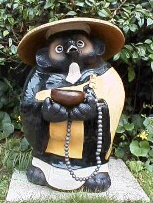
Magical Tanuki dressed as pilgrim.
Modern; From Kanjizai-Ji Temple on the
Shikoku Pilgrimage to 88 Holy Sites
|
LIST OF MAJOR BUDDHIST PILGRIMAGES IN JAPAN
The below list starts in the north (Hokkaido) and ends in the south (Kyushu). This list is based on a Japanese-language page found at www5f.biglobe.ne.jp/~fkm-ito. The below list is not comprehensive; rather, it is a sampling of the most recognized Buddhist pilgrimages in Japan, followed by various links to specific circuits and deities. In addition to these Buddhist Pilgrimages, there are many other special circuits for Japan’s Holy Mountains (this page) and Sacred Shinto Sites.
- 北海道三十三観音霊場 33 Kannon Sites (Hokkaido)
- 津軽三十三観音霊場 33 Kannon Sites (Tsugaru, Aomori)
- 奥州三十三観音霊場 33 Kannon Sites (Ōshuu, Tohoku)
- 最上三十三観音霊場 33 Kannon Sites (Saijyou, Yamagata)
- 関東八十八ヵ所霊場 88 Holy Sites in the Kantō Region
- 関東三十六不動霊場 36 Sites Sacred to Fudō Myō-ō (Kantō)
- 関東八十八ヵ所霊場 Kantō Pilgrimage to 88 Holy Sites
- 坂東三十三観音霊場 Bandō Circuit, 33 Kannon Sites (Kantō)
- 秩父三十四観音霊場 Chichibu Circuit, 34 Kannon Sites (Saitama)
- 武蔵野三十三観音霊場 33 Kannon Sites (Musashino, Kantō)
- 鎌倉三十三観音霊場 33 Kannon Sites (Kamakura)
- 鎌倉十三仏霊場 13 Sites Sacred to the Jūsan Butsu (Kamakura)
- 西国三十三観音霊場 33 Kannon Sites (Saikoku, Western Japan)
- 西国薬師霊場 Pilgrimage to Yakushi Nyorai (Western Japan)
- 新西国霊場 New Western Japan Circuit (Osaka, Nara, Kyoto, etc.)
- 大和十三仏霊場 13 Sites Sacred to Jūsan Butsu (Yamato, Nara)
- 京都十三仏霊場 13 Sites Sacred to Jūsan Butsu (Kyoto)
- 中国三十三観音霊場 33 Site Sacred to Kannon (Chugoku)
- 四国霊場八十八ヶ所 88 Holy Sites of Shikoku (Shikoku)
- 四国別格二十霊場 20 Special Sites for Kōbō Daishi (Shikoku)
- 篠栗四国八十八ヶ所霊場 88 Sites (Shinokuri; Fukuoka)
- 九州八十八ヶ所霊場 88 Holy Sites (Kyushu)
- 九州四十九院薬師霊場 49 Sites for Yakushi Nyorai (Kyushu)
- 九州三十六不動霊場 36 Sites Sacred to Fudō Myō-ō (Kyushu)
- 九州西国霊場 Kyushu-Shikoku Pilgrimage to Holy Sites
- 九州三十三観音霊場 33 Kannon Sites (Kyushu)
- 九州二十四地蔵尊霊場 24 Sites Sacred to Jizō (Kyushu)
- 国東六郷満山霊場 Holy Places on Kunisaki Peninsula (Oita); Rokugōmanzan, Tendai
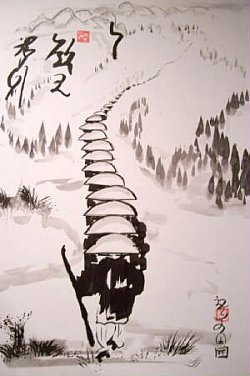
Zen Art by Qiao Seng
Available for Online Purchase
- PILGRIMAGE FORMATS. The multi-site format of most pilgrimages is one of the most prevalent pilgrimage formats in Japan. Multi-site circuits involve a number of sacred places linked together numerically, with each location devoted to the same single deity or to a group of related deities. This is known as honzon junrei 本尊巡礼 — literally to wander around (jun) to worship (rei) the principle deity (honzon). In order to complete the pilgrimage, participants are obliged to visit every single site on the circuit. Each site is equally important and none serve as the center or definitional locus. Although the sites are assigned numbers, participants can visit them in any order (the only prerequisite is that “all” are visited). The numbers indicate the most convenient route for those who are unfamiliar with the circuit’s logistics. Multi-site pilgrimages need not be completed in a fixed timeframe. Instead, participants can perform the circuit in multiple journeys spread out over any length of time. In bygone times, pilgrims often wore special pilgrimage garments. Today most wear everyday clothes and carry a book (nōkyō-chō) that can be purchased at any site along the route. This book is then stamped (for a small fee) at each site visited. These stamps (shu-in) are often very artistic, but their main function is to serve as a testimony to the pilgrim’s completion of the journey.
|
|

|
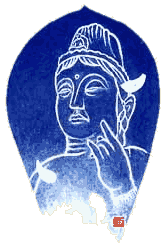 DEITY-SPECIFIC PILGRIMAGES DEITY-SPECIFIC PILGRIMAGES
Below list is not comprehensive.
KANNON PILGRIMAGES
- KANNON -- 100 Holy Sites. English. Complete listing of the traditional 100 sites sacred to Kannon in Japan. Making the circuit to each (Saikoku, Bandou, Chichibu) is said to save the believer from hell and to open the gates to everlasting life. One of the oldest and most popular pilgrimage circuits in Japan.
- 西国三十三観音霊場 (さいこく)
Saikoku Pilgrimage to
33 Sites in Western Japan (Kansai).
Japanese site showing temple
stamps from this circuit.
www5f.biglobe.ne.jp/~fkm-ito/html/frame01.htm (Stamps)
www5f.biglobe.ne.jp/~fkm-ito/htmlhuda/hfrm01.htm (Lists all 33; J)
- 坂東三十三観音霊場 (ばんどう)
Bandou (Bando) Pilgramage, 33 Kannon Sites (Kanto).
Japanese site. Stamps from the Bando Pilgrimage.
www5f.biglobe.ne.jp/~fkm-ito/html/frame08.htm (Stamps)
www5f.biglobe.ne.jp/~fkm-ito/htmlhuda/hfrm08.htm (Lists all 33; J)
- 秩父三十四観音霊場 (ちちぶ)
Chichibu Pilgrimage, 34 Kannon Sites in Saitama Valley
Japanese site. Stamps from the Chichibu pilgrimage.
www5f.biglobe.ne.jp/~fkm-ito/html/frame09.htm (Stamps)
www5f.biglobe.ne.jp/~fkm-ito/htmlhuda/hfrm09.htm (Lists all 34; J)
- KANNON -- ORIGINS OF THE KANNON 100 CIRCUIT. The Kannon Pilgrimage to 33 Sites in Saikoku (Western Japan, Kansai) dates from the Heian Period (794-1185 AD), but was reportedly founded earlier, in 718 AD, by the monk Tokudo Shonin 徳道上人. But the circuit did not become widely known. It was rediscovered by Emperor Kazan in 988 AD. By the Tokugawa period, the popularity of the Saikoku route led to its replication. Over 236 copies of the route spread throughout Japan, with more than 30% of these circuits located in Eastern Japan. Of these, the Bandō 33 route is considered the most important after the original Saikoku pilgrimage. Records are somewhat unclear on the origin of the Bandō Pilgrimage. According to the Sugimoto-dera Engi of 1560 AD, the Bandō Pilgrimage was designated in 988 AD by Emperor Kazan (aka Emperor Hanayama, 968-1008 AD). According to this text, Kannon Bosatsu appeared to Emperor Kazan in a dream, saying "I have divided into 33 bodies throughout the eight provinces of the Bandō area, and a pilgrimage to these 33 sites will bring release from suffering." Emperor Kazan, it is said, visited Sugimoto-dera in Kamakura and designated it as the first temple on the Bandō Pilgrimage. In later years, Sugimoto-dera also became the first temple in the Kamakura Pilgrimage to 33 Kannon Sites. But the Bandō pilgrimage remained little used and mostly unknown to commoners until after the Genroku Period (1688-1703 AD), when it became popular among lay people. By this time, both the Saikoku and Bandō pilgrimages were formally linked to a third circuit, the Chichibu Pilgrimage (Saitama area) to 34 Sites Sacred to Kannon, making a complete circuit of 100 sites (Hyakuban Kannon Fudasho 百番観音札所). Click here for more (Adobe PDF file) on the origins of the Kannon 100 Pilgrimage; from the Japanese Journal of Religious Studies, 1997 23/3-4; story by Mark W. MacWilliams.)
Finally, on the Saikoku and Bandō circuits, many temples belong to sects of Esoteric Buddhism. But on the Chichibu circuit, many sites are associated with Zen Buddhism, which in particular revers the Shō Kannon, the "pure" form of the Goddess of Mercy and Compassion.
- KANNON -- Kamakura Pilgrimage to 33 Sites
English. A complete listing of the 33 sites sacred to Kannon in Kamakura. Kamakura is only one hour by train from Tokyo.
- KANNON -- Western Japan, 33 Sites, Temple Stamps
KANNON -- Western Japan, 33 Sites, Sacred Images
Japanese. Called "Saigoku Sanjusankasho Meguri" in Japanese. This site provides an incredible collection of pilgrimage stamps and sacred images for numerous pilgrimage circuits.
- KANNON -- Kanto Region, 88 Sites, Sacred Images
Japanese. Sacred images of the various deities on this circuit, including Kannon, the Myō-ō, others.
- KANNON -- Shikoku, 88 Holy Sites, Kannon Photo Tour
Japanese. Wonderful photos of the Kannon statues found on this circuit. Photos courtesy of the Health Center Faculty of Medicine, Kagawa University. NOTE: Of the 88 temples in the Shikoku Pilgrimage, 29 are dedicated to Kannon.
- KANNON -- eStore for Kannon Pilgrimage Equipment
Japanese. eStore selling Kannon-related pilgrimage equipment and general pilgrimage paraphernalia.
- KANNON -- Who is Kannon Bosatsu?
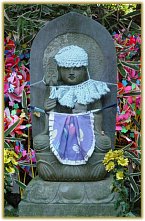 JIZŌ BOSATSU PILGRIMAGES JIZŌ BOSATSU PILGRIMAGES
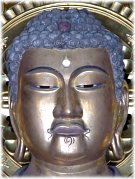 AMIDA NYORAI PILGRIMAGES AMIDA NYORAI PILGRIMAGES
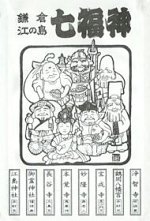 SEVEN LUCKY GODS PILGRIMAGES SEVEN LUCKY GODS PILGRIMAGES
|
|

|
O-HYAKUDO MAIRI
100 Pilgrimages at One Shrine
お百度参り (オヒャクドマイリ)
Also called hyakudomairi (hundred pilgrimages) and sengori (thousand purifications). Individual or group practice of traveling back and forth one hundred times between a shrine and some fixed place in that shrine’s precincts, praying each time. Often performed to gain divine aid in cases of sickness and disaster. <source: Online Shinto dictionary of the Institute for Japanese Culture and Classics, Kokugakuin University at www2.kokugakuin.ac.jp/ijcc/wp/bts/bts_o.html#o-hyakudo>
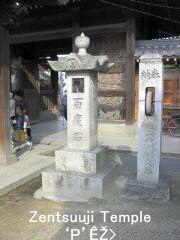
At Zentsuu-Ji (Kagawa, Japan)
kagawa.bine.jp/pblog/article.php?id=125
You turn the wheel and make a prayer on
each of the 100 circuits in your pilgrimage.
Photo Tour of Hyakudo Mairi Stones
http://kagawa.bine.jp/jinnjya/topix/100do/100do.html
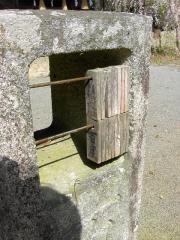
See the wooden slabs in above photo.
You push aside one each time you reach the stone,
until they are all on the other side, completing your 100 walks.
Courtesy of http://kagawa.bine.jp/jinnjya/topix/100do/100do.html
There are variants. In some shrines, when you turn the wheel, you have to make sure nobody sees you, otherwise your wish will not come true. Therefore this pilgrimage is usually practiced in the dark of the night. <source from tctv.ne.jp/tobifudo/HandS/tango/hyakudo/hyakudo.html>
There is a Japanese Buddhist variant of the Hyakudo Mairi Shinto tradition that involves the beloved Jizō Bosatsu. It is called the 地蔵車. This translates as the Jizo Wheel (which includes the afterlife wheel, 後生車, ごしょうぐるま) and the Bosatsu wheel (菩提車, ぼだいぐるま). Found in front of many temples. When you say your wish while turning the wheel downward, a wish for the afterlife will be granted. When you turn the wheel upward, a wish for your present life will be granted. For details, please see: www.fmkagawa.co.jp/yomu/88/88-56.htm.
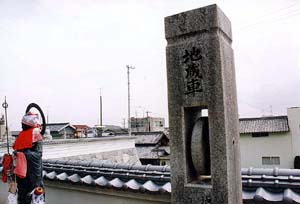
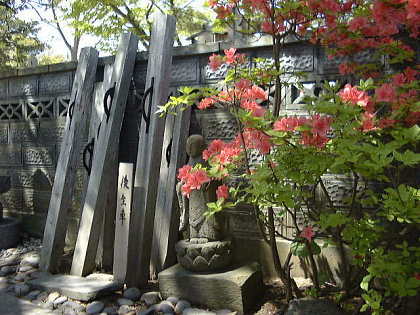
Jizō Wheel at Dazaifu
Courtesy of www.jomon.ne.jp/~oldpine/photo4.html
For more, please see Japanese language site at:
http://homepage3.nifty.com/yukijuku/karafune/k35.htm
|
|

|
 SHIKOKU -- PILGRIMAGE TO 88 HOLY SITES SHIKOKU -- PILGRIMAGE TO 88 HOLY SITES
On the Japanese island of Shikoku are the 88 Sacred Sites connected with Kūkai 空海 (774 - 835 AD; Saint Kōbō, Priest Kōbō, aka Kōbō Daishi 弘法大師), the founder of the Shingon Sect of Japanese Esoteric Buddhism). Local folk call pilgrims of this circuit Henro 遍路 or O-Henro-san. This circuit is one of the most traditional, popular and famous among the Japanese. Says Steve McCarty: “It takes about 60 days to hike the 1,647 kilometers, going deep into rugged mountains, plodding along sandy beaches, rocky coasts, through fields and hills, villages and towns. The Shikoku Pilgrimage is nonsectarian, even though Kukai was the founder of the Shingon Sect of Japanese Buddhism. Pilgrims seem to forget their Buddhist sects in worshiping Kobo Daishi (aka Kukai) who stands far beyond factionalism. Not all of the 88 holy sites are temples of the Shingon Sect, either.”
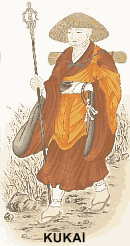 The Shikoku Holy Places Association estimates that 150,000 tourists completed the island's 88-temple pilgrimage in 2002, up 50,000 from just five years ago. Kōbō Daishi (aka Kūkai) founded this 88-temple pilgrimage. He also reportedly invented the Japanese kana system, and is the undisputed founder of the Shingon sect. This pilgrimage follows the circuit that Kūkai is believed to have walked on a solitary journey towards enlightenment. There are countless folk tales and special sites in Shikoku and other parts of Japan associated with this priest, one of the most popular saints in Japanese Buddhism. Most devotees carry a staff bearing the words "we two walk together (ni-nin doogyo)," a proxy for the first pilgrim. <above paragraph courtesy of J@pan.Inc.> The Shikoku Holy Places Association estimates that 150,000 tourists completed the island's 88-temple pilgrimage in 2002, up 50,000 from just five years ago. Kōbō Daishi (aka Kūkai) founded this 88-temple pilgrimage. He also reportedly invented the Japanese kana system, and is the undisputed founder of the Shingon sect. This pilgrimage follows the circuit that Kūkai is believed to have walked on a solitary journey towards enlightenment. There are countless folk tales and special sites in Shikoku and other parts of Japan associated with this priest, one of the most popular saints in Japanese Buddhism. Most devotees carry a staff bearing the words "we two walk together (ni-nin doogyo)," a proxy for the first pilgrim. <above paragraph courtesy of J@pan.Inc.>
Among the 88 Shikoku sites, the highlight for many pilgrims is Zentsuji Temple, said to be the birthplace of Kūkai (Kōbō Daishi). Kūkai is also the founder of the Mt. Kōya monestary, one of the most famous in all of Japan for adherents of the Shingon Sect of Esoteric Buddhism. The entire Mt. Kōya area has been a popular pilgrimage destination since the Heian Era (794-1185 AD).
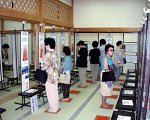 Sunafumi Ceremony. Walking on Sacred Sand お砂踏み. Sunafumi Ceremony. Walking on Sacred Sand お砂踏み.
For those unable to make the trek to Shikoku, there is a temple in Tokyo, Setagaya Ward, called Tamagawa Daishi. Twice each each, the temple holds a special ceremony in May and October, from the 21st to the 23rd, wherein people can pray in front of hanging scrolls of the 88 Temples of the Shikoku Pilgrimage whilst standing on a bag of sacred sand from each respective temple. For much more on this ceremony, which is held at many other temples among the sects of Esoteric Buddhism, please visit gabigreve2000/sunafumi.html. Above photo courtesy of: chisan.or.jp.
Souja 総社 or 惣社. Also pronounced Sousha, Subeyashiro. Text courtesy JAANUS
A shrine that contains many dieties, which may have individual shrines in distant parts of Japan, thus enabling worshippers easy access to such dieties without the necessity of travel. Such a shrine may also be called Kanjou 勧請. According to some, this custom was originated in the Nara period by a practical-minded provincial governor. He created a consolidated shrine near the provincial capital in order to eliminate the arduous task of visiting all the shrines under his jurisdiction. There were also country and village Souja. Such shrines have various styles. Example = Souja Honden 総社本殿, 1657, in Okayama prefecture.
Outside Links About Shikoku 88 Pilgrimage
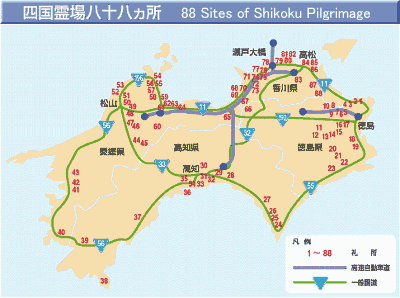
SHIKOKU: How to Make the Shikoku Pilgrimage
by Akiko Takemoto and Steve McCarty
www.waoe.org/steve/shikoku/pilgrimage.html
Usually the pilgrimage is made clockwise. But some people deliberately make it counterclockwise as did Emon Saburo until he finally succeeded in meeting the Daishi. The number 88 represents the number of evil passions identified by Buddhist doctrine, and ideally it is believed that one can get rid of all evil passions by visiting each of the 88 temples. In that sense, visiting even one temples is better than none. <Editor’s Note. Other Buddhist traditions say there are 108 basic desires, not 88 >
Temple #1 on the circuit is where pilgrims are given the Buddhist Ten Commandments to follow at least during the Pilgrimage: Do not kill. Do not steal. Do not commit adultery. Do not tell a lie. Do not use flowery language. Do not speak ill of others. Do not be double-tongued. Do not be covetous. Do not be angry. Do not be perverse.
The most authentic pilgrims go on foot all the way, spending about two months, because walking is closest to following in Kobo Daishi's footsteps. Traditionally there are two pilgrimage seasons, spring and autumn, with the equinoxes as the climax, when pilgrims are generously presented with o-settai (donations, or free gifts of food and drink) by local people at the temples. But all year round visitors are seen at the temples.
Many still wear the formal costumes of Shikoku Pilgrims - the sedgehat, the wooden staff, the white suit and pouches, all bearing their motto written in calligraphy 同行二人 (dougyou ninin) meaning "Daishi and I, going together" or 南無大師遍照金剛 (Namu Daishi Henjo Kongo) meaning "I put my faith in Daishi, the Universal Adamantine Illuminator."
Of all the equipment, the most important is the staff. It is not just for practical use when one hikes along rugged paths in the mountains, but it is a holy symbol of the Daishi himself. So pilgrims always treat it with utmost care and reverence. In former days the same staff became one's grave post if one died on the way, as was often the case in those days when everyone had to walk all the way. That is why the top of the staff is designed like a Buddhist grave post. In fact, the white suit itself was and still is nothing but death garments.
If the temple has a bell tower, one is expected to strike the bell announcing one's arrival to the temple divinities and Kobo Daishi. Most pilgrims go to an office called the Noukyou-sho 納経所 (or Noukyou-jou 納経場) in or around the main hall to have the temple's signature inscribed in fine calligraphy and its vermilion seal stamped in their album or scroll or on their white jacket (about 200 yen). <end quote>
|
|

|
Zenkoji Temple Pilgrimage (Nagano)
http://www.japan-guide.com/e/e6001.html
One of the most visited temples in Japan, Zenkoji was founded 1,400 years ago and stores, what many believe to be, the first Buddhist statue ever brought to Japan. A copy of the statue is shown to the public every seven years for a few days. The next opportunity will be in 2010. Most recently rebuilt in 1707, Zenkoji's main hall has a tunnel in its basement in which visitors are trying to find and touch the "key to paradise" in complete darkness. The key is attached to the wall and grants enlightenment to anybody who touches it.
|
|

|
 HOLY MOUNTAINS HOLY MOUNTAINS
Mt. Kōya, Mt. Tateyama, Mt. Hakusan, and Mt. Fuji are four of the most widely known holy mountains in Japan, but there are many sacred peaks in this island nation. Many are associated closely with the spread of Buddhism during the Heian Period (794-1185 AD), especially the mountain asceticism of the Shugendō 修験道 sect, which combined Shinto beliefs with Buddhist doctrine and practice. Its practioners are called yamabushi 山伏 (mountain ascetic or priest). Mountain worship in Japan is referred to as Sangaku Shinkō 山岳信仰, which literally means “mountain faith.” Records suggest such worship emerged well before the introduction of Buddhism to Japan in the 6th century AD. Another common term, meaning “religious mountain practices,” is Sangaku Shūkyō 山岳宗教. Although some Japanese refer to the Nihon Sanmeizan (lit. “Japan's three most sacred mountains”) of Mt. Fuji, Mt. Tateyama, and Mt. Hakusan, this is a very arbitrary designation, and it should not be taken at face value. The below list is not comprehensive. Indeed, one Japanese list (not available herein) recognizes 43 sacred mountains. Hopefully, at some time in the future, a larger, more comprehensive list, will be made available at this site.
MT. KŌYA (KII PENINSULA, WAKAYAMA)
Sacred Mountain for Shingon Sect of Esoteric Buddhism. A mountain monastery called Kongobuji was established here in 816 AD by Kūkai (aka Kōbō Daishi, 774 - 835 AD, founder of Japan’s Shingon Sect). Kūkai is also intimately associated with the Pilgrimage to the 88 Holy Sites of Shikoku. Since its founding until today, Kongōbuji has served as the center of Shingon Buddhism in Japan, and Mt. Kōya remains one of modern Japan’s most popular pilgrimage sites. The monastery is a vast repository of Buddhist art, especially mandalas, and home to a large number of graves. Dainichi Nyorai and Fudō Myō-ō are two of the sect’s most revered deities. Kōbō Daishi’s name literally means “great teacher of Buddhism.” Kōbō Daishi is also credited with creating Japan’s hiragana syllabary.
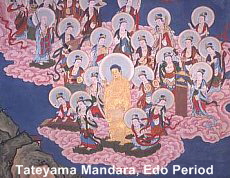 MT. TATEYAMA (TOYAMA) MT. TATEYAMA (TOYAMA)
By the 8th century AD, Mt. Tateyama was already a mecca for mountain ascetics. Otomo-no-Yakamochi, the celebrated writer of the famous Manyoshu (8th century), mentions in one of his poems the cult of Tateyama worship, which in those days was intimately linked to the Pure Land sect of Buddhism (Amida worship, Jodo Sect). In later times, the mountain retreat also became influenced by the Jodo Shinshu Sect (New Jodo), also centered around Amida worship.
MT. TATEYAMA (TOYAMA)
www.rekihaku.ac.jp/e-rekihaku/100/cover.html
Tateyama, which rises in the eastern part of Japan’s Etchu region (present day Toyama Prefecture), has long been considered a sacred mountain. In the Edo Period, proselytizing warrior monks carried Tateyama mandala images across all of Japan, using them as pictorial teaching materials. Amida, Kannon and Seishi, the three Buddhas who welcome believers to the Western Paradise, and 25 welcoming bodhisattvas and celestial beings, are shown in the heavens above the Tateyama Range which is shown as the Western Paradise. In the lower section various scenes of hell, such as a pond of blood, Children's Limbo, and a fiery chariot, are depicted.
TATEYAMA MANDARA
Anyone in the land of Japan
who has committed sins
will fall into the Tateyama hells.
From Honcho Hokke Genki (11th century);
anonymous. Translation Anna K. Seidel.
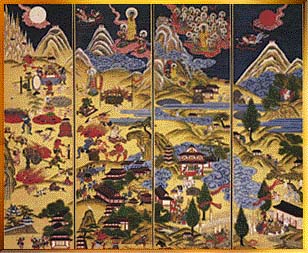
立山曼荼羅の解説 富山県[立山博物館]
www2.ocn.ne.jp/~tomoya1/sub2.html
Japanese Site. Tremendously interesting images of the
Tateyama Mandara, with numerous images of beings from hell.
The above and below photo came from this site.
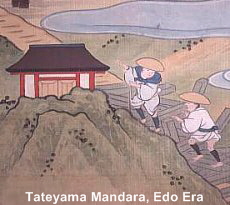 The opening of the Tateyama mountains went on at a feverish pace during the Heian Period. The religious implements discovered at Tsurugidake summit have been verified as being from the early Heian Period. Tateyama was chosen long ago as the Land of Pure Bliss or Hell on Earth, and it has drawn together people of faith as a center of the Shugendo Sect (of Shingon). It is recorded in Tales of Times Now Past that Jigokudani (Hell Valley 地獄谷) in Tateyama was the place that the departed spirits of the entire nation would fall into. With the introduction of the Tateyama Mandala in the Edo Period, many mountaineering ascetics were said to have traveled all over the country on foot carrying the mandala to spread the word. <from kohiyama.wem.sfc.keio.ac.jp/eng/> The opening of the Tateyama mountains went on at a feverish pace during the Heian Period. The religious implements discovered at Tsurugidake summit have been verified as being from the early Heian Period. Tateyama was chosen long ago as the Land of Pure Bliss or Hell on Earth, and it has drawn together people of faith as a center of the Shugendo Sect (of Shingon). It is recorded in Tales of Times Now Past that Jigokudani (Hell Valley 地獄谷) in Tateyama was the place that the departed spirits of the entire nation would fall into. With the introduction of the Tateyama Mandala in the Edo Period, many mountaineering ascetics were said to have traveled all over the country on foot carrying the mandala to spread the word. <from kohiyama.wem.sfc.keio.ac.jp/eng/>
TATEYAMA Jigoku-Dani (Hell Valley)
So-called for its sulfur vents and boiling pools. Gas and vapor rise from the ground and strange noises are heard, creating an eerie atmosphere. According to legend, there are 136 hells where ghosts appear to ask hikers for help.

MT. HAKUSAN (The White Mountain; 2,702 meters)
Since 717 AD, when Buddhist Priest Taicho founded the Mt. Hakusan retreat, Mt. Hakusan has been known as a religious mountain with a small secluded shrine on the top. Hakusan is one of the Nihon Sanmeizan, or Japan's three most sacred mountains (along with Mt. Fuji and Mt. Tateyama). The mountain is celebrated in the Man’youshu, which was compiled in the eight century. The cult of mountain asceticism developed rapidly in the Heian period and the mountain's Shugendō sect was a form of Shinto/ Buddhist syncretism. The three Shinto deities Izanagi no Mikoto, Izanami no Mikoto, and Kukurihime no Kami are connected with Mt. Hakusan. Kukuri is the goddess who arbitrated between Izanagi and Izanami and is the Dragon Goddess of Hakusan. On the mountaintop also live Shoichi Hakusanmyori Daibosatsu (Bodhisattva) -- said to be the Buddhist incarnation of the 11-Headed Kannon (Juichimen Kannon) -- and Betsuzan Daigyoji, said to be the embodiment of the Shō Kannon (the “pure” manifestation of the Kannon Bosatsu in Japan).
Hakusan Gongen is the Shinto kami of Mt. Hakusan, once a great Shugendo center. Hakusan Gongen is an avatar of the Eleven-Headed Kannon, and also a representation of the Shinto kami Izanami.

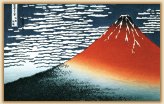 MT. FUJI (Fuji-san) MT. FUJI (Fuji-san)
Mt. Fuji (3,776 meters) is the symbol of Japan and the country's tallest mountain. Long regarded as sacred, it became a popular pilgrimage sometime in the 15th century. The official climbing season is July and August, and approximately 200,000 people make the pilgrimage during those two months -- although you can still visit and climb the mountain all year long. Many tourist spots surround Mt. Fuji these days, smothering the sacred air with the clouds of commercialism. Perhaps in recognition of this growing tourist element, there is a Japanese saying: “Every Japanese should climb Mt. Fuji at least once, but only a fool climbs it twice.” Mt. Fuji is the subject of countless works of art in Japan. The above photo, for instance, is from the famous ”Thirty-Six Views of Mt. Fuji,” a series of woodblock prints by Hokusai.
MT. FUJI (Fuji-san)
www.sacredsites.com/asia/japan/
Mt. Fuji has acquired an ancient and enormous corpus of myth regarding its divine origins, resident deities, and spiritual powers. The soaring peak has been venerated as the home of a fire god, later the dwelling of a Shinto goddess of flowing trees, and since Buddhist times, the abode of Dainichi Nyorai, the Buddha of All-Illuminating Wisdom. According to early Shugendo myths the mountain was first climbed by the wizard-sage En no Gyoja around 700 AD, but it is more likely that the first ascents began in the 12th or 13th centuries. From the 15th century onwards Fuji became a popular pilgrimage destination. Women were not allowed to scale the mountain until the time of the Meiji restoration (1868) but today nearly half of the 400,000 climbers per year are women.
 MT. FUJI AND SENGEN SHRINES MT. FUJI AND SENGEN SHRINES
www.japan-guide.com/e/e2059.html
浅間神社 (せんげん). Sengen Shrines (also read “Asama”) are dedicated to the mythical princess Konohana Sakkuya Hime (also spelled Konohanasakuya; also known as Koyasu-sama), the Shinto deity of Mount Fuji and of cherry trees in bloom. The Shinto goddess Koyasu-sama is also revered as a goddess who grants easy childbirth. But after Buddhism gained a strong foothold in Japan, Koyasu-sama was supplanted by her Buddhist equivalents, known as Koyasu Kishibojin, Koyasu Kannon, and Koyasu Jizo. For more, please see Guardians of Children. More than one thousand Sengen Shrines exist across Japan, with the head shrines standing at the foot and the summit of Mount Fuji itself. More on Asama Shrine here (Japanese site).

MT. NANTAI, Nantai San, Kurokiyama, Futa-ara-san (Tochigi)
www.sacredsites.com/asia/japan/
A place of Shinto pilgrimage since at least the 4th century AD. Local legends tell of a powerful mountain spirit that assisted hermits and monks in spiritual realization, and by the 8th century Nantai-san was a favored site for Buddhist practitioners on solitary retreats. Near town of Nikko, just north of Tokyo. For more, click here (outside site).
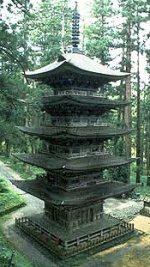 MT. HAGURO, Haguro San 羽黒山 MT. HAGURO, Haguro San 羽黒山
(Yamagata Prefecture)
The three deities of sacred Mt. Haguro (and the Haguro Shugendo sect) are Myōken Bosatsu, the deification of the Pole Star and the Dipper constellation; Gundari Myō-ō, who represents the six marker stars of the south; and the central divinity Kannon Bosatsu.
According to Maison Franco-Japonaise: “The founder of Haguro Shugendo (at Dewa Sanzan) is Nojo Taishi, who is said to have come to Haguro early in the seventh century. He was given the title of Shoken Daibosatsu in the 19th century. Legend says he was the third son of the late sixth century emperor Sushun, and the cousin of the famous Shotoku Taishi. He is depicted as a strange being, dark of skin and with exaggerated facial features, his mouth extending from ear to ear. It was to a place called Akoya, in a narrow valley full of thick growth, with a waterfall at one end, that Nojo Taishi was guided by a mystical three-legged crow, and it was here that he first did ascetic training. Here also he found a statue of Kannon Bosatsu and it was from here that he opened the three mountains (Dewa Sanzan) as a Shugendo site.”
Says SacredSites.com: Area frequented by the yamabushi, or mountain ascetics, of Shugendo Buddhism. These three sacred mountains, called Dewa Sanzan -- Haguro (419 meters), Gassan (1980 meters), and Yudono (1504 meters) -- were probably venerated in pre-historic times, but trace their historical sanctity to an imperial prince of the early 7th century. The prince (Nojo Taishi) renounced his title and position, took the name of Kokai, and became a wandering mountain hermit. While on a beach in the Dewa province, he saw an enormous black bird with three legs that led him first to Mt. Haguro and then to the other two holy peaks. Kokai stayed the rest of his years upon Haguro, where his imperial grave is maintained to this day. Mt. Haguro is the seat of one of the two main Shugendo orders and the wooded peak has some of the most massive and beautiful temples in all of Japan. For more, click here (outside site).

MT. ONTAKE, Kiso Ontake (Nagoya)
http://hkuhist2.hku.hk/nakasendo/ontake.htm
Authored by Thomas A. Stanley and R.T.A. Irving
Mount Ontake is an active volcano which erupted, for the first time in recorded history, in 1979. Dominating the Kiso Valley, it is better known, perhaps, as the domain of magical mountain spirits. Also called Mitake and Otake, Mount Ontake is sometimes called Kiso Ontake in order to distinguish it from a number of other mountains with similar names. One of the other mountains, Mitakesan or Mt. Mitake in Tokyo prefecture, and Kiso Ontake both are Shinto centers of worship, particularly by the Shugendo sect which specializes in ascetic practices on mountains. Kiso Ontake has its shrine at the foot of the mountain and is the headquarters of the Mitakekyo ("Mitake teaching"). In addition to the groups of Shugendo believers who ascend the mountain to perform their rites, local farmers also worship there early in the spring as it is believed that the mountain's god descends to the rice fields in the spring and ensures fertility in the coming year. This folk belief is typical of the Shinto concentration on natural wonders and fertility. The Shugendo sect, and its sub-sect, the Mitakekyo, are very eclectic sects which combine Shinto beliefs with Buddhist doctrine and practice. Its believers are usually called yamabushi (lit. mountain warriors or mountain ascetics), who may often be hermits. Shugendo emerged in the 12th century as a result of the joining of solitary hermits who had fled Buddhist monasteries to seek magical and medical powers through fasting, meditation and ascetic practices such as standing under cold mountain waterfalls or in snow. Shugendo was, until recently, a very secretive group since its beliefs and rituals could only be passed on from master to disciple after a certain level of practice had been achieved. Yamabushi ascend sacred mountains like Ontake in each of the four seasons which have their own austere practices designed to arouse the Buddha-like nature that lies within. In 1875, the sect was banned when the Meiji government tried to insist on complete separation of Shinto and Buddhism, but it survived underground until 1945 when new policies implemented by the Allied Occupation insisted on religious freedom.

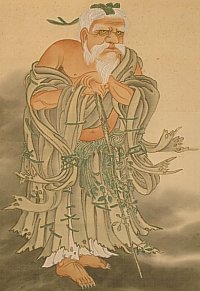 MOUNTAIN HOLY MAN MOUNTAIN HOLY MAN
En no Gyouja 役行者
Learn much more on our Shugendō page.
Below text from JAANUS
Also known as En no Ozunu 役小角 (also read En no Shoukaku) and En no Ubasoku 役優婆塞. A semi-legendary holy man noted for his practice of mountain asceticism during the second half of the 7century AD. Typically he is represented wearing a white hooded robe and a pair of clogs, which have one support instead of the usual two. He holds a staff and Buddhist prayer beads in his hands and is usually seated on a rock base accompanied by two demons (oni 鬼). En no Gyouja was known as a diviner at Mt. Katsuragi 葛木 on the border of Nara and Osaka Perfectures. Mentioned in early Japanese texts, the NIHON RYOUIKI 日本霊異記, and the SHOKUNIHONGI 続日本紀 as having magical powers that enable him to cast spells, he is also said to have had two demon attendants who gathered water and firewood for him. In 699 he was accused of misleading the people and expelled to Izu 伊豆. Though his life story is riddled with folklore, he is idealized as the founder of Shugendou 修験道, a syncretic religious order which combined elements of ancient pre-Buddhist worship of mountains (Sangaku Shinkou 山岳信仰) with the doctrine and ritual of Esoteric Buddhism (Mikkyou 密教). It is believed that he climbed and consecrated many mountains, making sanctuaries in such places as Mt. Kimpusen 金峰山 and Mt. Oomine 大峰 in Nara Pref. He was given the posthumous name of Shimben Daibosatu 神辺大菩薩 (Miraculous Great Bodhisattva). Artwork depicting En no Gyouja dates from the Kamakura period or later and is often found in temples of the Shingon 真言 sect, strongly influenced by Mt. Oomine mountain asceticism. He is known by various names:
- En no Ubasoku 役優婆塞
- En no Ozunu 役小角
- En no Shoukaku 役小角
- Posthumous name is Shinben Daibosatu 神辺大菩薩
(Miraculous Great Bodhisattva)
- <end JAANUS quote>
Learn much more about Enno Gyoja at our Shugendō Page.
Shinto Buddhist Blending
www.sacredsites.com/asia/japan/
During the Heian period (793-1185) Buddhist temples were increasingly built on the sides and summits of many Shinto sacred mountains. It was believed that the native Shinto kami of these mountains were in reality manifestations of Buddhist divinities thus pilgrimage to the mountains was believed to bring favors from both the Shinto and Buddhist divinities simultaneously.
ALSO SEE:
|
|

|
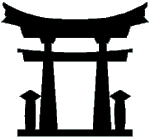 SACRED SHINTO SHRINES SACRED SHINTO SHRINES
See our Shrine Guide for many more.
ISE JINGU SHRINE (MIE PREFECTURE)
According to myth, Amaterasu Omikami, the Great Sun Goddess, traveled throughout Japan seeking her eternal resting place, and finally decided to settle in Ise. In modern times, about six million Japanese visit Ise Jingu each year. From December 31 to January 5, around one million Japanese journey to Ise Jingu for Hatsumoude (初詣) -- the first prayers of the New Year.
www.japan-guide.com/e/e4300.html
The Ise Jingu consists of two shrines: the Outer Shrine (Geku), which is dedicated to Toyouke, the kami of clothing, food and housing, and the Inner Shrine (Naiku), which enshrines Amaterasu, the Sun Goddess. They are considered to be Japan’s most sacred Shinto shrines.
OKAGE MAIRI -- ISE JINJGU
(Okage Mairi literally means "Thank You God")
www.e-net.or.jp/user/tmt/063_inside.html
Okage Mairi (the special pilgrimages to the Ise Shrines made in the "Okage Year," which comes about ever 60 years). The custom arose during the last half of the Kamakura period (1192-1333 A.D.) among the general population. Many people got together to make group pilgrimages to the Ise shrines in hopes of being offered a great blessing. For generations, thousands of Japanese have made the pilgrimage from their hometown to Ise Jingu. It was the dream of people to visit Ise-Jingu at least once in their lifetime. In the Edo Period, Okage-mairi, thanksgiving pilgrimage was a phenomenon occurring every sixty years that stirred commoners across the country. People who believed the rumors of amulets falling from heaven impulsively set out to visit the Shrine without permission from family and employers or obtaining permit from government officials in days when people were not allowed to travel freely. It is said that every month 228,000 people flocked to Ise, singing and dancing while holding ladles in their hands. People living along the street placed money and food into the ladles along with giving clothes.
NUKE MAIRI (Secret Pilgrimage) -- ISE JINJGU
In the Edo era, people would set out impulsively to visit the Ise Shrine without permission from family and employers or obtaining permit from government officials in days when people were not allowed to travel freely.
ISE JINGU - Pilgrimage Stamps (Mie Prefecture)
Japanese, Outside Link. Ise is one of Japan’s most sacred shrines.

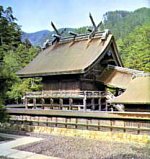 IZUMO TAISHA SHRINE IZUMO TAISHA SHRINE
www.sacredsites.com (English)
www.izumooyashiro.or.jp (Japanese)
Izumo Taisha is considered to be the oldest and most important Shinto shrine in all of Japan. The main shrine is dedicated to Okuninushi-no-kami, a Shinto deity (Buddhist equivalent is Daikokuten, of Hindu origin, now one of Japan’s Seven Lucky Gods).
According to the Kojiki (the Legendary Stories of Old Japan) and the Nihon Shoki (the Chronicles of Japan), these being the two oldest books in Japan appearing around 720 AD., the main Izumo shrine was the largest wooden structure in Japan prior to 1,200 AD.

KUMANO SANZAN SHRINES (Kumano Hongu Taisha)
Three Sacred Shrines in Wakayama, World Heritage List
Famed for centuries for its shrines and said to be the home of the legendary Tengu Goblin, the slayer of vanity. The Kumano region is very mountainous, with steep ridges, complicated peaks, and vast gorges. One of the most prominent religious sanctuaries since the Heian Period.
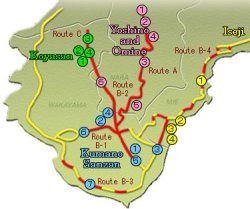 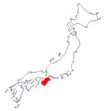
- KUMANO SANZAN SHRINES
www.kippo.or.jp/isan_e/kii.html (English)
Three mountain areas in particular, Yoshino-Omine, Kumano Sanzan, and Koyasan, came to be revered as sacred places associated with certain religious groups. Respectively, these were the Shugendo branch of ascetic Buddhism, another sect practicing Shinto-Buddhist Syncreticism or the belief that Japan's traditional gods are incarnations of Buddhist deities), and the Tendai and Shingon sects of esoteric Buddhism, each with their own distinct identity, yet interacting. Along the Omine Okugakemichi pilgrimage route, the strict 'okugake' training rituals of the Shugendo practitioners continue to be practiced and the Kumano Sankeimichi and Koyasan Choishimichi pilgrimage routes also draw large numbers of people seeking such paths to enlightenment. All of these have had a profound influence on the formation of Japan's spiritual culture.
- KUMANO SANKEIMICHI NAKAHECHI
sekaiisan-wakayama.jp (English; Wakayama Pref. World Heritage Center)
tb-kumano.jp/en/world-heritage (English; Tanabe City Kumano Tourism Bureau)
The three sacred shrines, plus two sacred temples -- Seiganto-ji and Fudarakusan-ji -- are connected by the pilgrimage route, the “Kumano Sankeimichi Nakahechi.” Please explore these wonderful English web sites for more on the Kumano Pilgrimage.
- KUMANO LINKS
-- http://city.bungotakada.com/kankou-sin/jouhou/
-- www.aisf.or.jp/~jaanus/deta/k/kumanomandara.htm
-- kotodama.kokugakuin.ac.jp/digital/diglib/kumano-m/html/05.html
-- kotodama.kokugakuin.ac.jp/digital/diglib/kumano
-k/mag2/pages/page001.html
-- wkdhaikutopics.blogspot.com/2007/05/kumano.html
-- www.mcedit.com/search/?mode=article&url=/archive/
Wingspan/2004/September/JAB.html
-- www.divinehumanity.com/custom/japanpilgrimage.html

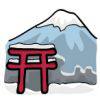 KOTOHIRA SHRINE (KONPIRA; KAGAWA) KOTOHIRA SHRINE (KONPIRA; KAGAWA)
Became extremely popular pilgrimage in 14th century. Very popular even today. The approach requires the pilgrim to climb 785 stone steps to get to the Main Sanctuary. But his is only half way up Mt. Zozu-san. Altogether, pilgrims must climb 1,368 stone steps to arrive at the Inner Shrine. Kotohira is also called “Konpira Moode” (金毘羅詣).
Enshrines the same god as at the Izumo Shrine. But Kotohira is also home to the god of the sea and has long been a place of worship for fishermen and seafarers. The poor samurai in the nearby port of Marugame, a castle town, made uchiwa fans, which they sold to the fishermen pilgrims. The mountain deity also protects the health of the people and wards off evil influences, and has been worshiped since olden times. In the Muromachi Period in the 14th century, pilgrimages to Konpira became a fad. The flow of worshipers from around Japan has never ceased, even today. Elephant's Head Mountain Range = Zozuzankei, or Zozu-san
MT. FUJI, SENGEN SHRINES (ASAMA)
See above entry for Mt. Fuji.
|
|

LEARN MORE
 Return to PART ONE of Pilgrimage Guide
Return to PART ONE of Pilgrimage Guide